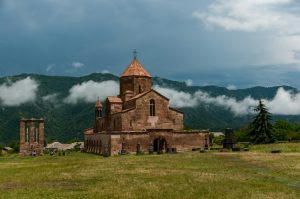Nestled at the crossroads of East and West, Armenia’s culture unfolds like an intricate tapestry, woven through millennia. This land, steeped in history and adorned with the vibrancy of its traditions, invites us on a journey to explore the essence of Armenian identity.
From the creation of its unique alphabet to the joyous steps of traditional dances, Armenia’s cultural landscape is a testament to the enduring spirit of its people. Indeed, Armenian culture is not merely a relic of the past – it’s a living, breathing proof of the power of preservation and the importance of community.
As it continues to evolve, adapting to the changing tides of history, it remains a shining example of how culture can serve as a bridge between people, connecting us through the shared language of heritage and humanity. Read our article to find out more about the rich Armenian culture and traditions.
The Alphabet: A Foundation of Identity
The Armenian alphabet, created by Mesrop Mashtots in the 5th century, is more than a set of characters. It is the cornerstone of Armenian identity, facilitating the spread of Christianity and enriching the nation with a treasure trove of literature. Ancient manuscripts, illuminated with exquisite miniatures, reveal a rich literary tradition and the art of illumination that has survived the test of time.
Armenian Family Culture: Celebrating Milestones
At the heart of Armenian society lies the family, revered and celebrated, with traditions that nurture the next generation. Among these, the agra hatik ceremony stands out, marking a baby’s first tooth with a ritual that foretells their future.
Objects symbolizing various professions are laid before the child, and their choice is seen as a harbinger of their path in life. This unique celebration part of the Armenian family culture underscores the importance of family and tradition in shaping individual destinies.
Armenian Food Culture: A Feast for the Senses
The Armenian food culture is another highlight, where meals are not just about nourishment but are a celebration of life and community. The saying “We have bread and salt among us” epitomizes the significance of food, symbolizing friendship and hospitality. Lavish spreads featuring an array of dishes reflect the warmth and generosity of Armenian hosts, inviting guests to partake in a culinary journey that delights the senses.

Dance and Music: Rhythms of Joy and Unity
Dance is the pulse of Armenian cultural expression, with traditional dances such as Kochari, Yarkhushta, and Berd echoing the nation’s soul. These dances, passed down through generations, are a highlight of family gatherings and public festivities, showcasing the vibrancy of the country’s heritage through elaborate costumes and spirited performances.
Art and Architecture: Echoes of Faith and Creativity
Armenia’s architectural landscape is dominated by its churches and religious structures, a legacy of its medieval past. The fusion of domestic and foreign influences has birthed a distinctive style, particularly in Christian architecture. The nation’s artistic endeavors are equally noteworthy, with a long history of painting, carpet-weaving, and crafting khachkars (cross-stones), embodying the deep connection Armenians have with their historical and religious roots.
The Diaspora: Spreading Wings, Preserving Roots
The Armenian diaspora has been instrumental in promoting the country’s culture across the globe. With vibrant communities from Russia to the United States, Armenians have managed to forge a global identity while maintaining their cultural heritage. This diaspora serves as a bridge, connecting Armenians worldwide and ensuring the continuity of their rich traditions.
A Culture Carved by History
Armenia’s cultural landscape has been shaped by its interactions with empires and civilizations over millennia, from the Persians to the Ottomans. These diverse influences are woven into the fabric of the culture of Armenia, enriching it with a variety of artistic, linguistic, and traditional elements.
In the heart of every Armenian, there lies a deep reverence for their ancestral heritage, a commitment to preserving it, and a desire to celebrate it with the world. The rich tapestry of Armenian culture, with its blend of tradition and resilience, continues to thrive, ensuring that the country’s spirit remains indomitable now and for generations to come.

